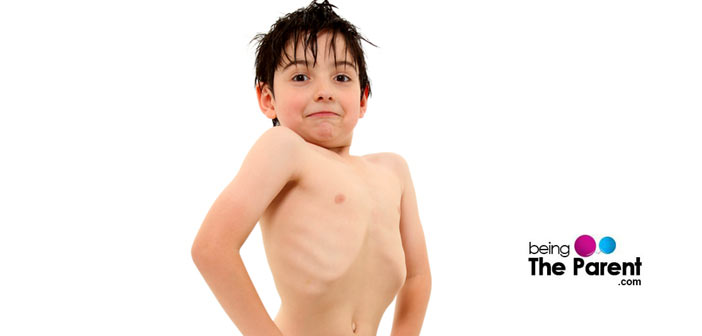
Helping Your Underweight Child
4 min readWritten by Editorial Team


Chubby cheeks with a rosy glow, twinkling mischievous eyes, shiny, thick hair – is this the image that you have set for your child? Well, you would say that healthy children appear healthy too. Unfinished plates, dragged meal times, and an exhausted child is frustrating and raises concern whether your child is getting all the nutrition to grow up as he should? Read below to know how to identify if your child is underweight and how you can overcome this:
Determining If The Child Is Too Skinny
The easiest way of identifying if your child is malnourished is his appearance – all bones and little flesh! He may also have:
- Sullen eyes
- Pale skin
- Brittle nails
- Gets exhausted easily
- Pale lower eyelids
Apart from the appearance of the child, growth charts are easily available on the Internet or pediatrician’s clinic, which denote the average height and weight of the child for respective age and gender. If your child’s weight gain is not approximately within the specified range, then it may be said that he has poor weight gain.
Sometimes, it runs in the family – the trait of being skinny and underweight. But you should be careful. If this is not the case, then there may be some underlying medical condition.
Nutrition That Your Child Could Be Missing
The most common reason for skinny appearance or malnourishment of the child is – adequate consumption of calories. In addition to this, he may be missing out on essential protein, iron, vitamins, carbohydrate, and fat intake too.
It’s best to consult the pediatrician or a dietitian and devise a diet chart for your little one. You can discuss the eating habits, the likes and dislikes of the child, and accordingly come up with a meal plan suited for your kid.

12 Tips To Help The Child to Gain Weight
Poor weight gain simply denotes one thing – inadequate food/calorie intake. Children aged 2-3 years need about 1,000 calories each day, whereas those aged 4-8 years require approx. 1,200 – 1,400 calories every day.
- Enforce: “Eat first, then drink” rule. Many times, children have fizzy drinks or juices before meals and at any time they want. Such drinks do not have any nutritional value, are filling, and reduce the hunger for eating any food.
- Instead of carbonated drinks or simply sherbets: serve fruit smoothies or milkshakes. Their nutritional content is high, as well as provide more calories.
- Limit junk food: Do not be swayed by junk food to fulfill the calorie requirements. Yes, they are deep-fried, and kids like them, but they do more harm than good.
- Go healthy: You can make cheese sandwich/pizza at home, feed cereals, chocolate protein bars.
- Have dry fruits: Add dry fruits to the daily menu. Almonds, cashews, walnuts, prunes – whatever your kids like, they are rich in antioxidants and calories.
- Let the taste guide the kid: Basically, feed them whatever they like, be it chicken biryani or dal makhani – they are good for your child. Most children like Chapatti smothered with ghee, or you can add a small dollop of ghee to the dal, and it magically enhances the flavor.
- Butter, anyone: Make stuffed parantha, with his favorite filling (minced meat, potato, cauliflower, etc.) accompanied by butter or white butter (Makhan).
- Keep realistic expectations: Don’t expect your child to finish everything in one go. He may not be able to finish the entire parantha at lunch. The key is to keep frequently feeding – probably at a gap of 2-3 hours.
- Set up a schedule: Make sure to feed your child 3 to 4 meals and 2 to 3 snacks each day. Children quickly adapt to fixed schedules.
- Limit water intake: Make sure that your child doesn’t get hold of drinks at least one hour prior to the meal.
- To combat your child’s food aversion: Take him with you while shopping at the supermarket, allow him to pick his favorite breakfast cereal or fruit yogurt.
- Make the healthier version of junkies at home: For instance: Try fettuccini with pesto, make hash browns, garlic bread with boiled eggs, soups with croutons, etc. Why not present him an English Style breakfast consisting of beans, fried eggs, sausages, mashed potatoes, tomatoes, and some French fries?

What If The Child Still Doesn’t Gain Weight?
If the body is not nourished with essential nutrients, then the immune system remains underdeveloped or weakened. This makes the child more susceptible to falling ill. Consult the pediatrician for proper guidance.
Your pediatrician may prescribe multivitamin, calcium, and/or iron tablets to help the nutritional deficiency of your child. The doctor is likely to address other issues that may affect the eating behavior of the child. Stress in the family (new baby, fights, and separation), the socio-cultural background, any developmental disorder (autism, mental retardation), or any physical discomfort can adversely affect the food intake of the child. He may try to identify any food allergies or is there a problem in intestines absorbing nutrients (such as Celiac disease).
Depending on the level of underweight and malnutrition, it may take approx — three to six months to catch up with the recommended weight.
Be patient with your child and help him blossom into a beautiful and healthy individual.

Editorial Team,
With a rich experience in pregnancy and parenting, our team of experts create insightful, well-curated, and easy-to-read content for our to-be-parents and parents at all stages of parenting.Read more.
Responses (0)
Want curated content sharply tailored for your exact stage of parenting?
Sponsored content
Discover great local businesses around you for your kids.
Get regular updates, great recommendations and other right stuff at the right time.











